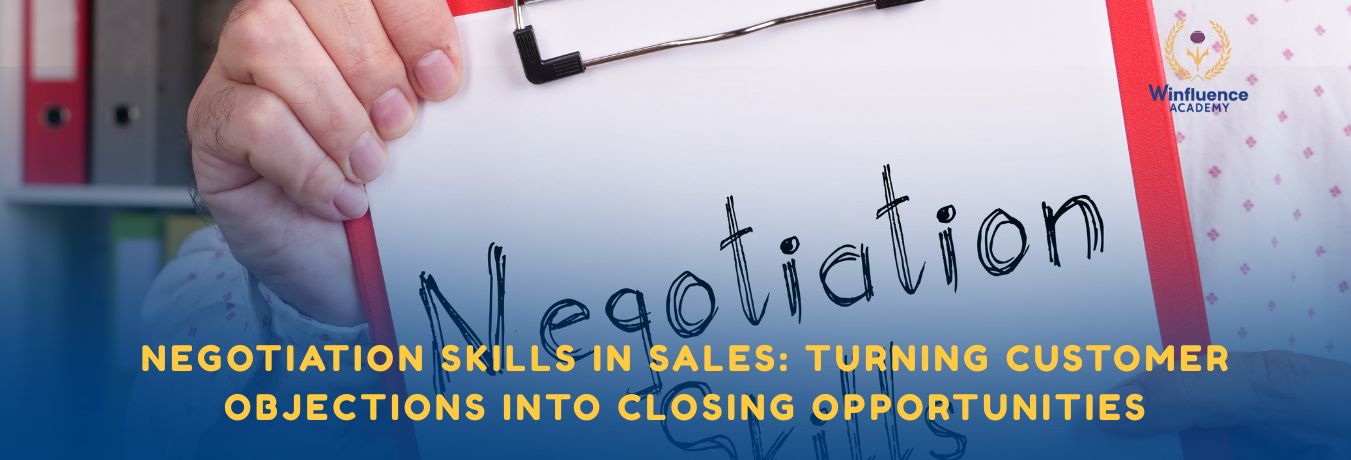Sales is rarely a straightforward process. Even when a product or service aligns with customer needs, objections often arise. These objections—whether related to price, timing, trust, or features—are not barriers but opportunities. They provide valuable insight into what the customer values most and open the door to building stronger connections. Mastering Negotiation Skills in Sales is about transforming these objections into stepping stones toward successful deals.
In today’s highly competitive marketplace, sales professionals must go beyond rehearsed pitches. They need to listen, adapt, and engage with clients in ways that address concerns authentically. By cultivating strong negotiation strategies, salespeople can create win-win outcomes that lead to customer satisfaction and long-term loyalty.
Understanding Customer Objections
Customer objections are natural in any sales process. They often reflect hesitation rather than outright rejection. Common objections include:
- Price Concerns – The customer feels the product is too expensive or not worth the cost.
- Timing Issues – Buyers may claim it’s not the right time to purchase.
- Product Fit – Customers doubt whether the solution will meet their specific needs.
- Competitor Comparisons – Buyers reference alternatives they are considering.
- Trust and Credibility – Concerns about the company’s reliability or service quality.
When faced with these concerns, inexperienced salespeople may respond defensively or retreat too quickly. However, skilled professionals see objections as an invitation to engage deeper, clarify misunderstandings, and prove value.
Why Negotiation Skills in Sales Are Essential
Sales is less about persuasion and more about problem-solving. Modern buyers are informed, cautious, and value-driven. They expect conversations, not lectures. Negotiation Skills in Sales enable professionals to handle resistance with confidence, fostering dialogue rather than conflict.
Strong negotiation abilities help salespeople:
- Build Trust – By addressing objections respectfully, customers feel heard and understood.
- Highlight Value – Effective negotiation reframes objections to emphasize benefits.
- Create Collaboration – Instead of pushing products, negotiation turns the process into a joint decision-making effort.
- Close Deals Efficiently – Addressing concerns upfront shortens sales cycles and increases conversions.
The ability to manage objections isn’t just about closing one deal; it’s about setting the stage for lasting relationships.
Turning Objections into Opportunities
The difference between a lost sale and a closed one often lies in how objections are handled. Here are strategies that transform hesitation into progress:
1. Listen Actively Before Responding
Many salespeople rush to counter objections with rehearsed responses. Instead, active listening builds trust. When a customer expresses concern, pause, acknowledge their perspective, and confirm your understanding. This shows respect and creates openness for dialogue.
2. Empathize with the Concern
Customers want to know their concerns are valid. Respond with empathy: “I understand why budget is a concern. Many of our clients felt the same initially…” This approach aligns you with the customer rather than against them.
3. Reframe the Objection
A skilled negotiator reframes objections as opportunities to emphasize value. For instance, if the price is too high, highlight the long-term savings, return on investment, or premium service quality that offsets the cost.
4. Ask Clarifying Questions
Objections often mask deeper issues. By asking, “Can you share more about what makes the timing difficult?” you uncover the root cause, which allows for tailored solutions.
5. Provide Evidence and Proof
Case studies, testimonials, and performance data reassure buyers. Concrete evidence transforms uncertainty into confidence, making objections less intimidating.
6. Offer Flexible Solutions
Sometimes, negotiation requires creative problem-solving. This could include flexible payment plans, trial periods, or customized packages. Flexibility demonstrates commitment to the customer’s needs.
7. Know When to Close
After addressing objections, many salespeople hesitate. Recognizing the right moment to ask for the sale ensures momentum isn’t lost. A confident close signals belief in the solution and builds trust in the buyer.
The Psychology Behind Objections
Objections often stem from fear—fear of making a wrong decision, losing money, or being taken advantage of. Effective negotiation skills in sales involve understanding this psychology and responding in ways that reduce risk perception.
- Fear of Cost – Counter with value and ROI.
- Fear of Inconvenience – Show ease of implementation.
- Fear of Regret – Highlight success stories and guarantees.
- Fear of Change – Emphasize support and guidance throughout transition.
When salespeople recognize the emotions driving objections, they can address both logical and emotional concerns, creating a stronger case for purchase.
Building Long-Term Value Through Negotiation
Closing a deal is important, but sustainable sales success depends on long-term relationships. Negotiation should never feel like manipulation; instead, it should foster trust and collaboration. Customers who feel heard are more likely to return, refer others, and become brand advocates.
A few practices for long-term success include:
- Transparency – Be clear about product limitations as well as strengths.
- Consistency – Keep promises made during negotiation.
- Follow-Up – After the sale, ensure customers are satisfied and supported.
- Continuous Improvement – Reflect on past negotiations to refine skills.
Practical Techniques for Everyday Sales Conversations
To integrate negotiation skills into daily sales interactions, professionals can apply the following methods:
- The “Feel-Felt-Found” Method – Acknowledge the objection (“I understand how you feel”), relate to others’ experiences (“Many clients felt the same way”), and provide resolution (“What they found was…”).
- The Contrast Principle – Present higher-value options first so the main offer feels more attractive.
- Silence as a Tool – Allowing space after addressing an objection often encourages customers to reflect and engage.
- Building Small Agreements – Gaining small “yeses” throughout the conversation builds momentum toward the final close.
These practical techniques, when combined with empathy and active listening, strengthen the sales process and make it more customer-centered.
Training and Continuous Development
Even experienced professionals benefit from refining their approach. Role-playing objection handling, attending workshops, and studying advanced strategies all contribute to mastery. Negotiation Skills in Sales are not innate—they are learned, practiced, and improved over time.
Companies that invest in training their sales teams see significant improvements in conversion rates and customer loyalty. By equipping teams with tools to handle objections effectively, businesses position themselves for long-term growth.
Conclusion
Customer objections should never be viewed as deal-breakers. Instead, they offer valuable insights—opportunities to better understand customer needs, communicate value more clearly, and build lasting trust. Negotiation skills in sales provide a powerful framework to turn resistance into agreement, hesitation into confidence, and potential rejection into long-term partnerships.
Ultimately, successful sales aren’t about pushing harder—they’re about listening better, responding strategically, and crafting win-win outcomes. By mastering the art of negotiation, sales professionals can turn objections into stepping stones that not only close deals but also open doors to continued success.
Want to turn every objection into an opportunity?
Join the Negotiation Course at Winfluence Academy and learn how to influence with confidence, clarity, and purpose.

